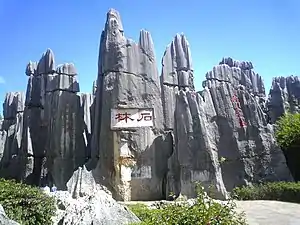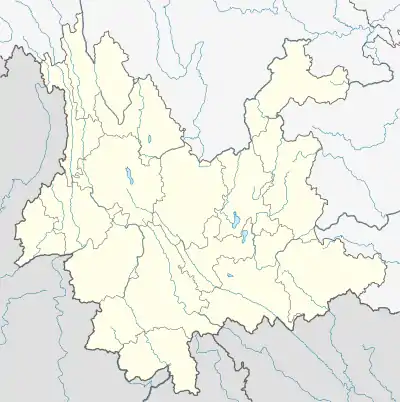Shilin Yi Autonomous County
Shilin Yi Autonomous County (Chinese: 石林彝族自治县; pinyin: Shílín Yízú Zìzhìxiàn: Yi: ![]() ) is an autonomous county, under the jurisdiction of Kunming, the capital of Yunnan province, China.
) is an autonomous county, under the jurisdiction of Kunming, the capital of Yunnan province, China.
Shilin Yi Autonomous County
石林彝族自治县 · | |
|---|---|
      From top, left to right: Skyline of the county urban, Shilin County government hall, Stone Forest, corn field in Shilin, a shopping plaza in Shilin, "Ashima" stone | |
| Etymology: Stone Forest | |
| Nickname(s): Hometown of Ashima | |
 Territory of Shilin Yi Autonomous County (red) in Yunnan Province | |
 Shilin Location of the seat in Yunnan | |
| Coordinates: 24°46′19″N 103°17′28″E | |
| Country | People's Republic of China |
| Province | Yunnan |
| Prefecture | Kunming |
| Founded | 1956 |
| Seat | Lufu Subdistrict |
| Government | |
| • County Head | Pu Jianyong (普建勇) (CPC) |
| • Secretary of CPC County Committee | Ran Detao (冉德涛) |
| Area [1]:534 | |
| • Total | 1,680.09 km2 (648.69 sq mi) |
| Elevation | 1,668 m (5,472 ft) |
| Population | |
| • Total | 260,400 |
| • Density | 150/km2 (400/sq mi) |
| Time zone | UTC+8 |
| Postal code | 652200 |
| Phone code | (0)692 |
| Website | sl |
Etymology
Lunan Yi Autonomous County (路南彝族自治县) is the former name of Shilin, and usually be called for short as Lunan County (路南县). The name of "Lunan" was first appeared in 1275, Yuan Dynasty, when the administrative division of Lunan Zhou (路南州) established.[3]:199 The name Lunan means "South of Middle Lu (中路)".[4]:367 But in 1998, another said of the word's origin meaning was proposed when Lunan County apply for change the name to Shilin. The research shows "Lunan" means "South People (the most inferior people in Yuan Dynasty citizen system) in Chengjiang Lu", it is a discriminatory name.[5]:20 Finally Lunan County was changed the name to Shilin, which means "stone forest", also is a famous tourist site in the county.[4]:367
History
Archaeological research show that as early as 800,000 years ago, humans began to settle in this region.[5]:19 Shilin area was dominated by Liangzhou (梁州) in Shang Dynasty, and was governed by Chu Kingdom and Dian Kingdom in Warring States period.[6]:108 In 111 BC., the Han Dynasty established counties in Yunnan area, and Shilin belonged to Tangao county (谈稿县), Zangke Jun (牂牁郡)[7]:555 (another said Lügao County (律高县), Yizhou Jun (益州郡)[8]:16). After Zhuge Liang marched to the south, Shilin was conquered and still by governed by Tangao County, Jianning Jun (建宁郡).[2]:42 In the Southern Dynasties it was dominated by Cuanman clans, and in early Tang Dynasty it was under the jurisdiction of Quanma County (泉麻县) and Longdi County (陇堤县) in Nanning Prefecture (南宁州).[7]:558[8]:16 In Nanzhao and Dali period it was under the rule of Tuodong Jiedu (拓东节度) and Shanchan Fu (鄯阐府),[9]:76 later under Shicheng County (石城郡).[10]:111 In 742, Salü City (撒吕城) was built on Mount Xuedi (学地山) in today's Shilin urban,[11]:13 which can be seen as the establishment of the county seat today.[12]:25 In 1255 Möngke Khan established Luomeng Wanhufu (落蒙万户府),[7]:564 and implemented tusi system here.[2]:42 In 1270, Luomeng and other two Wanhufu compounded to Middle Lu Zongguanfu (中路总管府).[11]:13 The Zongguanfu was separated to two Lu, Shilin was Lunan Zhou under Chengjiang Lu.[3]:199 Sani Qin clan is the tusi of Lunan Zhou. Lunan surrendered to Ming dynasty in 1382 and still by governed by Chengjiang Fu.[11]:26
Administrative divisions
Lufu Town, Shilin Town, Lumeiyi Town, Xijiekou Town, Changhu Town, Guishan Town, Banqiao Town and Dake Township.
Natural sites
The Shilin (Stone Forest), a set of remarkable karst formations, is part of the South China Karst, inscribed in 2007 on the UNESCO World Heritage List. Dadieshui Waterfall is the largest waterfall in Yunnan province, located at the southwest of county urban.
Solarpower station
- See also, Solar power in China
A large-scale solar power station in Shilin County had started construction on December 6, 2008. With a total installed capacity of 166 megawatts, the power station will be the largest experiment demonstration grid-connected solar photovoltaic power station in China.[13]
Climate
| Climate data for Shilin (1981−2010) | |||||||||||||
|---|---|---|---|---|---|---|---|---|---|---|---|---|---|
| Month | Jan | Feb | Mar | Apr | May | Jun | Jul | Aug | Sep | Oct | Nov | Dec | Year |
| Record high °C (°F) | 24.9 (76.8) |
28.0 (82.4) |
30.9 (87.6) |
32.7 (90.9) |
34.4 (93.9) |
32.0 (89.6) |
31.7 (89.1) |
31.5 (88.7) |
31.7 (89.1) |
29.0 (84.2) |
26.9 (80.4) |
26.3 (79.3) |
34.4 (93.9) |
| Average high °C (°F) | 16.7 (62.1) |
19.1 (66.4) |
22.8 (73.0) |
25.9 (78.6) |
26.4 (79.5) |
26.1 (79.0) |
25.9 (78.6) |
26.0 (78.8) |
24.6 (76.3) |
22.1 (71.8) |
19.2 (66.6) |
16.3 (61.3) |
22.6 (72.7) |
| Daily mean °C (°F) | 9.3 (48.7) |
11.3 (52.3) |
14.9 (58.8) |
18.5 (65.3) |
20.4 (68.7) |
21.2 (70.2) |
21.1 (70.0) |
20.7 (69.3) |
19.2 (66.6) |
16.7 (62.1) |
12.8 (55.0) |
9.2 (48.6) |
16.3 (61.3) |
| Average low °C (°F) | 3.8 (38.8) |
5.3 (41.5) |
8.6 (47.5) |
12.4 (54.3) |
15.7 (60.3) |
17.8 (64.0) |
17.9 (64.2) |
17.3 (63.1) |
15.7 (60.3) |
13.3 (55.9) |
8.4 (47.1) |
4.4 (39.9) |
11.7 (53.1) |
| Record low °C (°F) | −4.9 (23.2) |
−2.8 (27.0) |
−6.2 (20.8) |
2.2 (36.0) |
4.0 (39.2) |
11.4 (52.5) |
12.37 (54.27) |
12.1 (53.8) |
7.7 (45.9) |
4.0 (39.2) |
−2.2 (28.0) |
−8.9 (16.0) |
−8.9 (16.0) |
| Average precipitation mm (inches) | 17.0 (0.67) |
18.7 (0.74) |
20.6 (0.81) |
31.9 (1.26) |
89.8 (3.54) |
169.8 (6.69) |
183.8 (7.24) |
165.5 (6.52) |
106.2 (4.18) |
73.7 (2.90) |
43.3 (1.70) |
19.3 (0.76) |
939.6 (37.01) |
| Average relative humidity (%) | 71 | 64 | 58 | 57 | 66 | 78 | 82 | 82 | 79 | 80 | 77 | 76 | 73 |
| Source: China Meteorological Data Service Center | |||||||||||||
References
- Li Cheng (李赪) (2012). 《云南统计年鉴2017》 [Statistical Yearbook of Yunnan 2017] (in Chinese). Beijing: China Statistics Press. ISBN 978-7-5037-8267-1.
- 石林彝族自治县史志办公室 (2017). 《石林年鉴 2017》 [Yearbook of Shilin 2017] (in Chinese). Kunming: Yunnan Nationalities Publishing House. ISBN 978-7-5367-7599-2.
- Zhou Zhenhe; Li Zhi'an (李治安); Xue Lei (薛磊) (2009). 《中国行政区划通史·元代卷》 [History of Administrative Divisions of China · Yuan Dynasty Volume] (in Chinese). Shanghai: Fudan University Press. ISBN 978-7-3090-5601-3.
- Niu Ruchen (牛汝辰) (2016). 《中国地名掌故词典》 [History of Administrative Divisions of China · Yuan Dynasty Volume] (in Chinese). Beijing: China Social Press. ISBN 978-7-5087-5238-9.
- 石林彝族自治县志编纂委员会 (2006). 《石林彝族自治县志1989—2000》 [Annals of Shilin Yi Autonomous County (1989-2000)] (in Chinese). Kunming: Yunnan Nationalities Publishing House. ISBN 7-5367-3448-4.
- 石林彝族自治县史志办公室 (2009). 《云南石林旧志集成》 [Compilation of Historical Annals of Shilin, Yunnan] (in Chinese). Kunming: Yunnan Nationalities Publishing House. ISBN 978-7-5367-3984-0.
- Li Yan (李埏) (2001). 《不自小斋文存》 (in Chinese). Kunming: Yunnan People's Publishing House. ISBN 7-222-03309-2.
- Ma Biao (马标) (1917). 《云南省路南县志》 [Annals of Lunan County, Yunnan Province] (in Chinese).
- Shao Xianshu (邵献书) (1990). 《南诏和大理国》 [Nanzhao and Dali Kingdom] (in Chinese). Changchun: Jinlin Education Publishing House. ISBN 7-5383-1128-9.
- Duan Yuming (段玉明) (2003). 《大理国史》 [History of Dali Kingdom] (in Chinese). Kunming: Yunnan Nationalities Publishing House. ISBN 978-7-5367-2480-8.
- 昆明市路南彝族自治县志编纂委员会 (1996). 《路南彝族自治县志》 [Annals of Lunan Yi Autonomous County] (in Chinese). Kunming: Yunnan Nationalities Publishing House. ISBN 7-5367-1294-4.
- 《石林彝族自治县概况》编写组 (2007). 《石林彝族自治县概况》 [Overview of Shilin Yi Autonomous County] (in Chinese). Beijing: Publishing House of Minority Nationalities. ISBN 7-1050-8540-1.